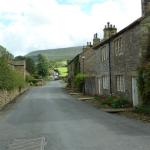
A young Englishwoman named Emma Jackson (1830-1885) converted to the church by 1852 if not earlier, because, by that year, she was in Liverpool preparing to emigrate to Zion. While still there in Liverpool she met a fellow convert named Samuel Lorenzo Adams (1833-1910). Eventually, Brother Adams was called into the office of the Presiding Elder — very possibly Elder Franklin D. Richards of the Twelve — and was informed that he could sail the next day. This put him in something of a dilemma. He told his leader of his affection for Emma and of his reluctance to leave her and his leader suggested that he marry her before sailing. Emma happened by the office on her way home from work, so the Presiding Elder called her in and married them on the spot, on 5 February 1852.
Samuel and Emma crossed the plains with what they wore on their backs and one change. But they made it. Samuel found work as a blacksmith’s helper. He built a one-room adobe home, roofed with dirt-covered wooden slabs. It was twelve feet by fourteen feet, with one door and one window and no furniture except a straw bed and a few boxes.
Emma soon had to cut the bed tick and remake it a foot shorter; she needed the fabric to patch the knees and seat on Samuel’s trousers. Then, by the spring of 1853, with their first child on the way, Emma sacrificed her one change of clothing and much of her petticoat in order to make two small nightgowns and two diapers for her baby and to remake her surviving dress in order to accommodate her pregnancy.
On 3 August 1853, the baby arrived. And then, minutes later, another baby arrived. Twin girls, Eleanor and Emma.
Samuel announced the news to his inquiring neighbors and informed them that Emma was doing fine. When one “young lass” heard that there were two babies, though, she turned tail and ran for home. Something, she knew, had to be done for these people.
Less than an hour later, a widow named Mary — herself not much better off than the Adamses — pulled up at the Adams cabin on an old gray horse. She brought with her a basket containing two lumps of butter — the first butter, Samuel later recalled, that had ever entered their home — along with a cooked chicken, and a large pan of buttermilk biscuits, which he described as “the first pan of white flour biscuits I had seen for months.”
The widow lady was inquisitive and determined, asking questions about what the Adamses needed. When they kept telling her that they were fine, she went outside and interrogated the neighbor woman who was serving as Emma’s nurse. Then, mounting her horse, she rode home.
Once there, she summoned her daughter and her stepdaughters. Sixteen-year-old Sarah offered the skirt of her white dress and her new flannel petticoat. Seventeen-year-old Jerusha made the same offer. Twelve-year-old Martha Ann offered the piece of white flannel that had just come from the loom for her. And Mary, the widow, provided some sheets that they had brought with them all the way across the plains and over the Rockies from Nauvoo.
Mary and the girls apparently worked through the night, because they arrived at the Adams home by nine o’clock the next morning, wanting to see the newborn twins and asking the privilege of washing and dressing them. Emma graciously declined the offer, saying that perhaps they could do so next time.
But the girls were insistent. And then they produced a large basket that they had been concealing. Not only did it contain the infant clothing that they had made, but also a quantity of food that they had managed to scratch together.
The two baby girls did well until, just after their first birthday, baby Emma died of whooping cough. Eleanor lived, though, and eventually herself became the mother of a large family. But not before again being visited by a painful family tragedy: In June 1865, when she was twelve years old, her younger brother and sister died on the same day of diphtheria.
Emma Jackson Adams was heartbroken. She had now lost three of her children. As her husband Samuel recalled, “She burst forth with ‘Oh, that God would only lighten my heart with knowledge of where my children are, or if anyone has the care of them.’”
Responding, Elder Erastus Snow, their neighbor in St. George and a member of the Quorum of the Twelve Apostles, promised Emma that, if she would resist the temptation to despair, “God our Father shall give you a witness of where and by whom your children are taken care of.”
The fulfillment of that promise came in two distinct parts, one of which involved young Eleanor:
It was late in July or early in August, the sun had set. The mother said to her eldest daughter . . . “Eleanor, go to the bedroom and get me Ettie’s night dress.” The girl obliged and started through the dining room . . . to the bedroom door. No sooner was the door pushed open than she, in a transfixed condition, beheld one of the most lovely sights the eyes of mortals ever beheld. A lady dressed in white apparel with long dark flowing hair hanging over her shoulders and with the most pleasant, happy countenance smiled upon her, and having two children upon her arms. Fear had fled from the mind of the little girl and she looked till her mind was satisfied. She identified the two little children; she had nursed and cared for one of them about two years, the other a few months, but there was still another personal [sic] whose age and face she could not comprehend. She viewed this to try and discover who it was. The vision presently passed away.
She returned to her mother in a very excited condition, saying, “Oh, Mother, I know you will not believe me, I cannot tell you what has happened.” She continued in this mood till about 9 o’clock next morning when to our joy she disclosed the foregoing story. After telling of John and Minerva she said, “Who was the little girl holding on to the skirt of the young lady and appeared to be about 12 or 13 months old?” We immediate [sic] informed her that she once knew the little girl but had forgotten her as she died at 13 months old and was her twin sister. She described the suit she was dressed in, even to the narrow satin ribbon her shoes were tied with, so that her mother could not fail to know it was her darling Emma.
In a later dream, Emma Adams was able to identify the young woman that Eleanor had seen caring for the departed children in her vision. It was a niece of hers, the very person who had introduced the Emma to the gospel. Needless to say, the bereaved mother was greatly comforted by these disclosures.
Incidentally, the widowed woman who visited with Emma Adams just after the birth of her twins was Mary Fielding Smith, the widow of the martyred patriarch Hyrum Smith. And the three girls with whom she created the clothing for the newborns and gathered the basket of food were Jerusha, Sarah, and Martha Ann, all of them daughters of Hyrum.
I heard this story of Emma Jackson for the first time just the other day, from Peter Fagg. I wrote it up here based on his brief online treatment of the first part of it and upon an article entitled “Eleanor and Emma” that can be found at Ardis E. Parshall’s valuable Latter-day Saint historical blog, The Keepapitchinin. The lengthy indented quotation comes from that article.
Posted from Cheltenham, Gloucestershire, England













